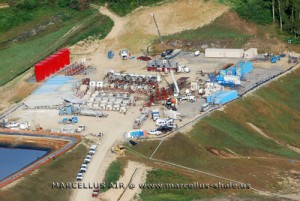
Executive Vice President,
Great American Group
Over the past 12 months, the rising price of crude oil, coupled with the move of energy companies away from coal, has resulted in the emergence of shale gas exploration in the United States and Canada. Shale gas production is a low-cost energy alternative that is creating new capital investment opportunities for private equity groups (PEGs) and asset-based lenders.
Shale gas extraction occurs through hydraulic fracturing and horizontal drilling. The U.S. Energy Information Administration (EIA) estimates the United States possesses more than 2,500 trillion cubic feet of technically recoverable natural gas resources, of which 33% is held in shale rock formations. The amount of natural gas recovered from shale has grown to 25% of U.S. gas production in just a decade and is expected to reach 50% by 2035, according to the EIA. Although the number of rotary rig counts for natural gas exploration declined in 2012 compared to the number of rigs used in crude oil exploration, the opportunity for the U.S. to export natural gas is growing.
The shale gas exploration boom began in 2005 and recoverable shale gas in the United States alone is estimated to exceed 100 years of the country’s current domestic needs. Shale gas production has grown at twice the rate of demand between 2005 and 2011. Driven by these dynamics, employment in the oil and gas sector is up 33% compared to five years ago.
This production growth, coupled with the mildest recorded winter in the U.S., caused wellhead gas prices to fall from $8 per million Btu (MMBtu) to under $2/MMBtu. Spot natural gas prices have trended up early during fourth quarter trading to reach $3.48/MMBtu — this after languishing between $2.50/MMBtu and $2.85/MMBtu for most of the second quarter.
The first quarter of 2012 saw increased drilling activity over 2011. In March 2012 the U.S. recorded a total rig count of 1,989 rigs, which represents 282 more rigs in operation compared to levels recorded 12 months earlier.

‘Trickle Down’ of Increased Drilling Raises Support Industries, Commodities
This increase in natural gas exploration has benefited several industries that support drilling activities. In early 2012, inventory appraisals of manufacturers and distributors of Oil Country Tubular Goods (OCTG) and Electric Resistance Welded (ERW) pipe saw sales revenues climb 70% to 90% higher than they were the previous year due to improved demand from oil and gas drilling.
Through the first half of 2012, the inventories of OCTG, ERW and Submerged Arc Welded (SAW), all seamless carbon and alloy pipe distributors in Texas, Oklahoma and Louisiana, increased inventories by 50% or more to meet actual and anticipated sales orders. By August 2012, pricing for domestic grade J55 ERW pipe measuring from 4.5 inches to 8.625 inches in diameter had softened to an average of $1,225/net ton versus $1,425/net ton in August 2011.
Domestic steel mills produce hot rolled coil, the base raw material for ERW pipe, and major mills in the U.S. include Nucor, U.S. Steel, Arcelor Mittal, Steel Dynamics, OAO Severstal and Gallatin Steel, among others. The major producers of ERW, SAW and seamless pipe include TMK-IPSCO, U.S. Steel Tubulars, Tenaris, Evraz, Tejas Tubulars and Boomerang Steel, some of whom have asset-based loan structures.
Oil and gas pipe and tubular distributors include McJunkin Redman, Pipeco Services, Bourland & Leveridge Supply, Edgen Murray, Pyramid Tubular Products and Alberta Tubular Products. Again, a number of these companies have asset-based loan structures.
According to U.S. Steel, the United States and Canadian demand for OCTG, welded tubular and seamless tubular products combined is 52% of the total worldwide demand — and is expected to exceed 12 million tons of consumption by the end of the year.
The dynamic progression of shale gas exploration has also created growth in oil field service companies where capital investment and asset-based lending opportunities have emerged, both in the U.S. and the Western Canadian Provinces.
Horizontal drilling and hydraulic fracturing are considered non-conventional drilling compared to vertical and directional drilling, and the amount of oil field machinery and equipment assets at a horizontal drill site with hydraulic fracturing is significantly higher than that required at a conventional drill site.
At the high end of the cost and valuation spectrum are late model frac pump units and the air drilling rigs. It is not uncommon for late model frac pump units and drilling rigs to have market values exceeding $800,000 each.
The pumping process requires a 50,000 pound to 80,000 pound gross vehicle weight (GVW) trailer that carries a 2,250 horsepower (hp) rated, 12-cylinder Cummins diesel engine to power a quintuplex pump rated at 12,000 pounds per square inch (psi). Additional equipment needed at the shale gas drill site includes the drilling rig, a frac fluids blending unit built on a trailer with an 80,000 pound GVW, over the road Class 8 (525 hp) tractors to haul the frac pump and frac blending trailers, acid tanker trucks, sand trailers, boom trucks, air compressors, generators, flatbed pipe trailers, crawler dozers and pickup trucks.
Oil field rental equipment companies that support horizontal and fracturing drilling operations, including Great Plains Oil Field Rentals, Knight Oil Tools, Circle T Rental and Alberta Oil Fields Rental, have seen revenue growth coupled with investment in new and reconditioned assets.
As natural gas prices weakened in 2012, drilling activity shifted more toward liquids-rich natural gas — particularly in the Bakken (Alberta)/ Williston Basin (North Dakota), Utica Shale (Ohio), Andarko Basin (Oklahoma), and the Permian and Eagle Ford Basins (Texas). Liquid rich or wet gas contains higher levels of ethane, butane and propane.
Drilling for dry natural gas slowed somewhat in the Marcellus Shale (West Virginia and Pennsylvania), Barnett Shale (Texas), and the Haynesville Shale (Louisiana and Texas). By mid-2012, dry gas drill rigs declined by 160 to roughly 613 rigs — while oil- and wet-gas rigs gained 800 rigs to total 1,337.
The weak pricing of natural gas also triggered energy utilities to move away from coal as their primary fuel for power generation. As such, the share of U.S. electricity that comes from coal is forecast to drop below 40% in 2012 — the lowest level since 1949 when the government started keeping records of this data — as utilities made the switch to the cheaper fuel source, natural gas. Analysts forecast that natural gas will be used to produce 29% of the power generated by U.S. utilities in 2012.
‘Going Green’ Spills Red Ink
The U.S. Government’s American Reinvestment and Recovery Act of 2009 (also known as the $800 billion Economic Stimulus Package), provided the U.S. Department of Energy (DOE), under §1705, a loan-guarantee program totaling more than $16 billion. A total of 26 projects were funded with the $16 billion. (In comparison, the Chinese Government announced in September that its five-year energy plan, from 2011 to 2015, includes $39 billion in solar power generation and will create 500,000 jobs.)
NRG Energy, Inc., based in Princeton, NJ, received the largest share of the DOE loan-guarantee program, $3.8 billion — representing a 24% share. The well-publicized solar manufacturer Solyndra, based in Fremont, CA, received $535 million and Abound Solar, based in Loveland, CO, received $400 million in loan guarantees.
Solyndra filed for Chapter 11 protection from creditors on September 6, 2011, as it and other solar panel companies were hurt by a flood of cheap imports from China that drove down prices. By November, 2011 the company hired an industrial liquidator to auction off the inventory, office furniture and real estate to repay its debts. In recent court filings, Solyndra has stated that the company may not be able to repay any of the $528 million loan that the U.S. government provided the company in 2009 to promote the clean energy industry.
Solyndra’s default was followed the next year by Abound Solar, which filed for Chapter 7 liquidation in early July. A manufacturer of thin-film solar panels, Abound Solar had received about $70 million of a $400 million loan that had been guaranteed by the DOE before it filed for bankruptcy. The company had also received $300 million in private investment.
Abound Solar selected Great American Group to liquidate the industrial assets of its four manufacturing plants. In early October, Great American Group began a two-day auction sale of Abound Solar manufacturing equipment including module manufacturing and related facilities equipment along with test chambers, microscopes, machine shop equipment, plant equipment and completed solar panels.
A month prior to Solyndra filing for Chapter 11 protection, San Jose-based SoloPower closed on a $197 million DOE loan guarantee.
Despite the previous financial failures of Solyndra and Abound Solar, SoloPower held a ribbon-cutting ceremony at its new plant in Portland, OR during September of this year — with company representatives voicing high optimism for its “thin film” flexible panels designed for commercial and industrial rooftop applications.
With the failures of Solyndra and Abound Solar, and the uncertainty of success among U. S. solar companies competing against the Chinese manufacturers of solar panels, energy analysts remain skeptical of SoloPower’s potential success.
There is also much uncertainty within the U.S. solar manufacturing industry regarding trade duties on Chinese solar goods that are being contemplated in Washington.
The U.S. Commerce Department, which has set combined preliminary duties of roughly 35% on most solar panels manufactured in China, will make a final decision on duties on October 10. The U.S. International Trade Commission (ITC) will then make a final decision in November on whether U.S. manufacturers were materially injured or are threatened with material injury by the Chinese imports.
The high-profile case, which has been emulated by solar producers in Europe and spawned threats of retaliation from Beijing, now largely turns on whether the ITC finds U.S. manufacturers have been materially injured, or are threatened with material injury, by the imports.
While a small contingent of U.S. solar manufacturers seek the higher duties to equalize the competitive landscape, some non-manufacturing segments within the U.S. solar industry say no American jobs will be created in the sector if the duties are imposed — and thousands could be lost in the solar installation and export sector if China does decide to retaliate, thus crippling U.S. demand in the long run.
The Coalition for Affordable Solar Energy estimates there are some 100,000 solar industry jobs in the United States, most of which are involved in the design, engineering, sales, installation and maintenance of solar systems.
Michael Petruski is Great American Group executive vice president & general manager of Machinery & Equipment and Disposition Services Mobile. For more information, contact 704-227-7161 or [email protected]; or visit www.greatamerican.com.
